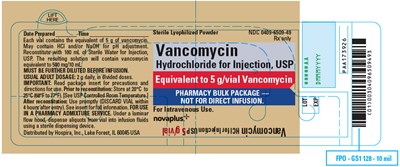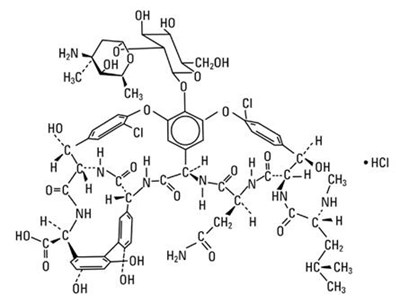Product Images Vancomycin Hydrochloride
View Photos of Packaging, Labels & Appearance
Product Label Images
The following 6 images provide visual information about the product associated with Vancomycin Hydrochloride NDC 0409-5017 by Hospira, Inc., such as packaging, labeling, and the appearance of the drug itself. This resource could be helpful for medical professionals, pharmacists, and patients seeking to verify medication information and ensure they have the correct product.
PRINCIPAL DISPLAY PANEL - 5 g Vial Label - vancomycin 03

Each vial contains the equivalent of 5 g of vancomycin which may contain HCI and/or NaOH for pH adjustment. The resulting solution will contain vancomycin equivalent to 500 mg/10 mL and must be diluted before infusion. This is a pharmacy bulk package and not intended for direct infusion. The text includes identification numbers and a warning to read package directions for use.*
PRINCIPAL DISPLAY PANEL - 5 g Vial Carton - vancomycin 04

This is a label for a Pharmacy Bulk Package for 5 grams per vial of Vancomycin, an antibiotic used to treat bacterial infections. The package is not meant for direct infusion and includes a copy-free area. There is no additional information available.*
vancomycin 05

This appears to be a description of a reconstituted bulk solution of a medication called Vancomycin Hydrochloride for Injection, which should not be used for direct infusion and requires further dilution before infusion. The package is for pharmacy bulk use only and comes with precautionary instructions and dosage information. However, the quality of the is poor, resulting in some gibberish text, and it may be necessary to refer to the original document for more accurate information.*
* The product label images have been analyzed using a combination of traditional computing and machine learning techniques. It should be noted that the descriptions provided may not be entirely accurate as they are experimental in nature. Use the information in this page at your own discretion and risk.


